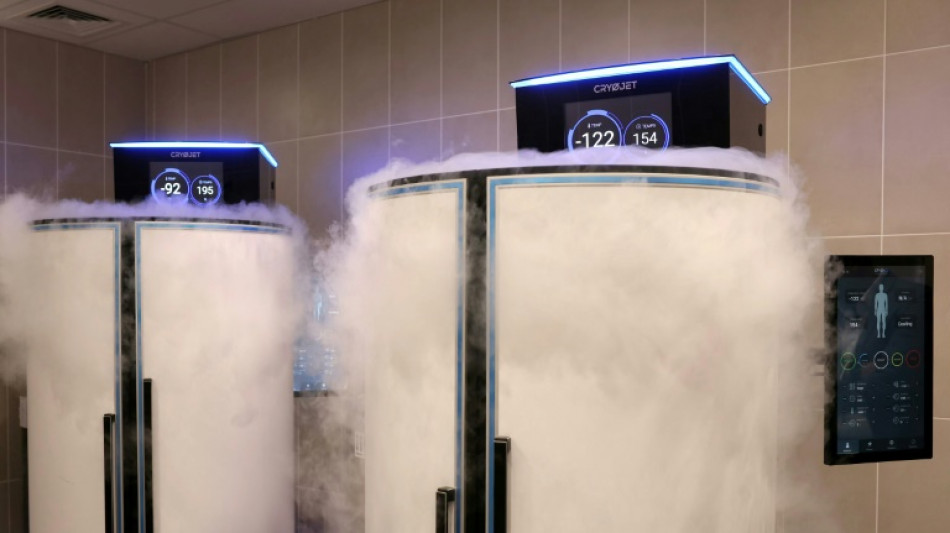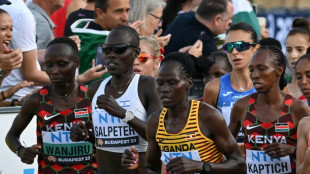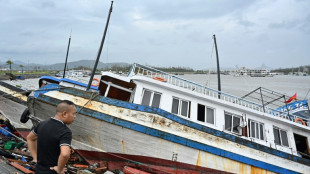
-
 Nissanka leaves Sri Lanka in sight of third Test win over England
Nissanka leaves Sri Lanka in sight of third Test win over England
-
Kendrick Lamar to headline 2025 Super Bowl halftime show

-
 Thousands defy roadblocks in rally for Pakistan ex-PM Khan
Thousands defy roadblocks in rally for Pakistan ex-PM Khan
-
Roglic wins record-equalling fourth Vuelta

-
 Russia advances in east Ukraine, launches deadly air strikes
Russia advances in east Ukraine, launches deadly air strikes
-
Cowboys quarterback Prescott agrees record $240 mln extension

-
 Swiss double in Paralympic wheelchair marathons, Dutch women retain basketball title
Swiss double in Paralympic wheelchair marathons, Dutch women retain basketball title
-
New 'Beetlejuice' creeps its way to top of N.America box office

-
 South Africa captain Kolisi leaves Racing 92: French Top 14 club
South Africa captain Kolisi leaves Racing 92: French Top 14 club
-
Funeral for slain athlete Cheptegei in Uganda on Sept 14

-
 Dolphins star Hill arrested on way to season-opener
Dolphins star Hill arrested on way to season-opener
-
Smith hits back after England collapse against Sri Lanka

-
 Weather delays final regattas in Louis Vuitton Cup
Weather delays final regattas in Louis Vuitton Cup
-
Venezuela's Gonzalez Urrutia: from placeholder to opposition pointman

-
 Marquez thanks rain for San Marino MotoGP win as leader Martin pays for gamble
Marquez thanks rain for San Marino MotoGP win as leader Martin pays for gamble
-
Boeing, union reach preliminary deal to avert Seattle-area strike

-
 Neuville wins Acropolis Rally to close in on world title
Neuville wins Acropolis Rally to close in on world title
-
Venezuela's opposition figure fled to Spain to save 'his life'

-
 Trump, Harris tied on eve of televised presidential debate
Trump, Harris tied on eve of televised presidential debate
-
Paris Paralympics the greatest ever, say former Olympics executives

-
 Pope exit revives Sri Lanka's hopes in third Test against England
Pope exit revives Sri Lanka's hopes in third Test against England
-
Gunman kills 3 Israelis at West Bank crossing as Gaza war rages

-
 Marquez wins San Marino MotoGP as leader Martin pays for rain gamble
Marquez wins San Marino MotoGP as leader Martin pays for rain gamble
-
Greece to hike fee for cruise passengers to Mykonos and Santorini

-
 Carsley's 'refreshing' England overhaul launches new era
Carsley's 'refreshing' England overhaul launches new era
-
Swiss double in wheelchair marathons on final day of Paralympics

-
 France's Le Pen urges Macron to hold referendum to break deadlock
France's Le Pen urges Macron to hold referendum to break deadlock
-
Typhoon Yagi weakens, toll rises to 14 in Vietnam

-
 India's Randhir Singh elected Asian Olympic chief
India's Randhir Singh elected Asian Olympic chief
-
Under pressure, UN winds down 'unique' Iraq probe into IS crimes

-
 'Proud' athletics great Weir calls time on marathon Paralympic career
'Proud' athletics great Weir calls time on marathon Paralympic career
-
'Brave' Afghanistan can beat anyone, says skipper ahead of NZ Test

-
 Vaughan warns England against 'taking the mick' after Sri Lanka collapse
Vaughan warns England against 'taking the mick' after Sri Lanka collapse
-
England's Moeen Ali retires from international cricket

-
 Japan's Hirata holds off inspired Smyth to win on Asian Tour
Japan's Hirata holds off inspired Smyth to win on Asian Tour
-
China's Paralympic domination fails to ignite enthusiasm back home

-
 Sporting a feathered headdress, Pope finds 'Eden' in Papua New Guinea
Sporting a feathered headdress, Pope finds 'Eden' in Papua New Guinea
-
Super Typhoon Yagi toll rises to 9 in Vietnam after landslide

-
 Indonesian villagers dress corpses in ritual for the dead
Indonesian villagers dress corpses in ritual for the dead
-
Williamson expects 'phenomenal' Root to keep breaking records

-
 The end of Olympic escapism for gloomy France
The end of Olympic escapism for gloomy France
-
Amy Adams gets real about motherhood in 'Nightbitch'

-
 Venezuela says presidential opposition candidate has left country
Venezuela says presidential opposition candidate has left country
-
Women ride Pakistan's economic crisis into the workplace

-
 Wallabies 'fell of cliff' in loss to Pumas, says coach Schmidt
Wallabies 'fell of cliff' in loss to Pumas, says coach Schmidt
-
Child abuse scandals hang over pope's East Timor visit

-
 Biden team, end in sight, keeps hope on Gaza truce despite setbacks
Biden team, end in sight, keeps hope on Gaza truce despite setbacks
-
Sabalenka dedicates US Open to family 'who never gave up' on dream

-
 Venezuela takes diplomatic jab at Brazil in spat over election
Venezuela takes diplomatic jab at Brazil in spat over election
-
Multiple people shot along highway in US state of Kentucky


From ice baths to osteopaths: unproven therapies at the Olympics
The Paris Olympics have been a showcase not only for athletic prowess but also for therapies such as ice baths and osteopathy which have little scientifically proven medical value, according to experts.
The Olympics have long been a fertile ground for questionable medical treatments, as athletes seek out every way possible to improve their performance and tamp down their pain.
"In sport there is a lot of propaganda for all kinds of 'alternative medicine' -- there is a lot of demand from athletes," French neurologist and pain specialist Didier Bouhassira told AFP.
At the Rio Games eight years ago, cupping was the latest pseudoscientific fad. Though praised at the time by athletes such as US Olympic swimming great Michael Phelps, there is little scientific evidence that applying heated cups to the skin has any more benefit than a placebo.
For this year's Games, which kicked off in Paris on Friday, ice has been all the rage.
Cryotherapy -- which includes cold-water swimming, ice baths and more advanced cooling chambers -- is touted to help athletes recover after vigorous exercise.
- The new ice age -
According to a recent editorial published in the British Journal of Sports Medicine, the federations taking part in the Paris Games together requested more than 16,000 tons of ice -- at a cost of 2.5 million euros ($2.7 million).
No vendor was able to supply such a massive amount of ice, so the Olympics will have to make do with 650 tons, the editorial said. That is still 10 times more than was required at the Tokyo Games only three years ago.
The editorial's authors criticised the routine use of cryotherapy for athletes between training sessions.
While ice baths can treat some conditions, such as heat stroke, athletes often use it "to obtain benefits which are not evidence-based," they wrote.
"Ice could have the opposite effect to that expected such as delayed tissue regeneration or impaired recovery."
The authors also stressed the environmental impact of producing, transporting and storing such vast amounts of ice.
- 'Long way from science' -
Another alternative medicine sought out by athletes -- osteopathy -- is no newcomer to the Olympics.
Osteopaths are on the staff of federations and integrated into the teams at the official Olympic clinic which monitors athletes daily.
But osteopathy, which promises to restore health through manipulations of the body, has little scientific basis and its effectiveness remains hotly contested.
Studies with rigorous methodology have found that broad swathes of the discipline -- such as "cranial" or "visceral" osteopathy -- simply have no effect.
Other osteopathic manipulations, which hew closer to those done by physios, appear to have no particular advantage over conventional, evidence-based physiotherapy.
A randomised clinical trial published in JAMA Internal Medicine in 2021 compared the effect of osteopathic manipulations with "sham" treatments such as light touching in 400 patients with back pain.
The difference between the two was "likely not clinically meaningful", the study said.
Osteopaths offer athletes a feeling of "well being without curative properties", said Pascale Mathieu, president of France's council of physiotherapists.
Mathieu emphasised she was not too worried about osteopathy being given a showcase at the Olympics, where routine care is often a mix of physiotherapy and osteopathy.
"What I'm really fighting for is to prevent osteopathy from entering hospitals," she said.
Some companies have also been accused of using the Olympics to sell products of dubious medical value.
French pharmaceutical giant Sanofi came under criticism for promoting a "pain-relieving" patch called Initiv in the run-up to the Games.
Advertised with the support of athletes such as French Olympian Kevin Mayer, Sanofi says the patch has particles which reflect infrared energy emitted by the body towards a particular area to relieve pain.
Sanofi told AFP that a clinical trial of the patch had been "received favourably by the scientific community".
But pain specialist Didier Bouhassira was not convinced.
"A product is being touted as a miracle, but it's pure PR and a long way from science," he said.
A.Santos--PC




